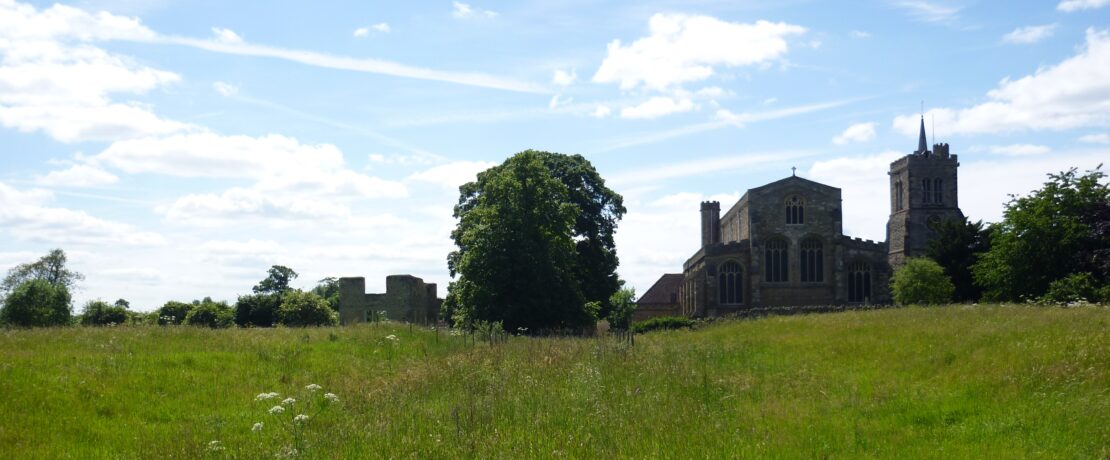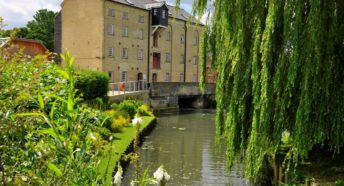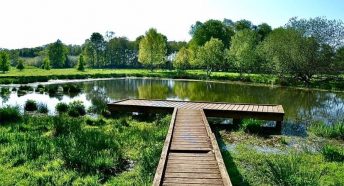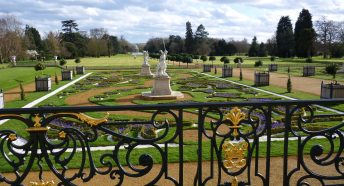A is for… abbey
Our new series of posts helping you to explore our county is an A-Z of Bedfordshire places, landscapes and history. Each post will include tips for walks and places to visit.
What is an abbey?
There are lots of names for these types of buildings that often seem to be used interchangeably. An abbey is a type of monastery used by members of a religious order under the direction of an abbot or abbess. The buildings, centred on a church, would have been home to groups of monks or nuns. The range of buildings on the site might have included dormitories, a dining room (refectory), an infirmary or hospital, guest accommodation, a library, kitchens, workshops and gardens.
Elstow Abbey
Elstow Abbey was home to a community of Benedictine nuns. Benedictine communities followed the Rule of St Benedict which was written in around 530. The rule is often summarised as ‘pray and work’ (ora et labore).
The abbey was founded in around 1075 by Judith, Countess of Huntingdon, a niece of William the Conqueror. In 1268 Henry III stayed at Elstow Abbey while attending a tournament in Bedford.
The nuns would have had daily contact with the priests who heard their confession and celebrated mass at the Abbey and with lay brothers working on the building and the lands it owned. Nuns wishing to go outside the Abbey precincts would have had to have been licensed by the Abbess but in 1421 the Bishop of Lincoln expressly forbade nuns from going into Bedford, Elstow or any other neighbouring town. The Abbey was dissolved in 1539 with many of the nuns retiring to Bedford.
The parish church of St Mary & St Helena is partially built from the remains of the Abbey.
Elstow village can be easily explored on foot. Aside from the Abbey, other notable features include the Moot Hall which was originally built to serve Elstow Abbey as a market house and is now a museum focusing on John Bunyan and seventeenth century life. Elstow Green played host to regular markets and fairs. The fairs held at Elstow are believed to be the inspiration for Bunyan’s Vanity Fair in ‘The Pilgrim’s Progress.’

Warden Abbey
Warden Abbey was a Cistercian monastery, founded in 1135. The Cistercians wanted to see a return to a stricter observance of the Benedictine rule. This often involved a return to manual labour, especially agricultural work. At Warden Abbey the self-sufficient holdings included two vineyards, pasture, gardens, fishponds, orchards, beehives, mills, dovecotes and farms. The abbey was surrendered to the Crown in 1537 during the Reformation. In 1545 the site was acquired by Robert Gostwick who built a red-brick farmhouse next to the site of the former abbey church. The building was demolished in the late eighteenth century and the site bought by the Whitbread family.
The vineyard was originally planted by medieval monks. They created a Great Vineyard (possibly about 24 acres) and an adjoining Little Vineyard (just over 16 acres), probably before the end of the 12th century.
The wine would have been used in a variety of ways in the monastery, the best wine was kept for services, high ranking clergy and special guests. Other uses included flavouring food, as a preservative, disinfectant, insect repellent and tonic. Wine mixed with water was widely drunk as the alcohol helped to kill bacteria found in water.
The Warden pear was once believed to have been introduced to England by Cistercian monks during the Middle Ages, taking its name from Warden Abbey. However, it’s now thought that ‘warden’ was a general term for a hard cooking pear. The name probably has its roots in the Anglo-Norman word warder, meaning ‘to keep or preserve’ and its capacity to last throughout the winter was one of its most important qualities.
Today the Warden Abbey Community Vineyard is managed by Bedfordshire Rural Communities Charity (BRCC) and is open to the public.
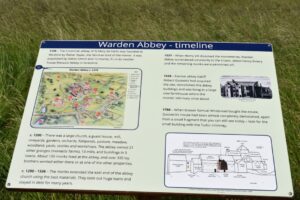
Woburn Abbey
Ten years after the founding of Warden Abbey, Woburn Abbey was also set up as a Cistercian community. It survived until 1538 when it was dissolved by Henry VIII. In 1547 it became the property of the Russell family, the Dukes of Bedford. The original abbey buildings were demolished in around 1630 and a new manor house was built. The imposing house we see today was built in the eighteenth century. None of the structure of the original abbey survives above ground.
The earliest reference to a deer park comes from 1661 when the fifth Earl of Bedford reserved the wooded deer park for his own use. Detailed records of the numbers of Red and Fallow Deer began to be kept in 1802. The number of species rose to over 40 under Herbrand Russell, the 11th Duke. From 1893 to 1914 he and his wife kept a register of births, deaths and purchases. New species added included Chinese Water Deer and Muntjac Deer.
There are public footpaths through the deer park. The Abbey and gardens are currently closed to the public for refurbishment. Maps of the area, including a footpath map for the deer park, can be found on the Woburn village website.
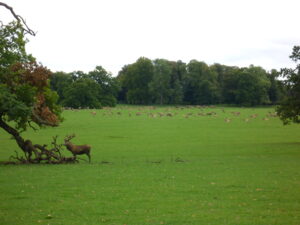
Turvey Abbey
Unlike the other three abbeys, which began life as religious houses before being put to other purposes, Turvey Abbey did not become home to a residential community until the 1980s. The nuns of the Priory of Our Lady of Peace moved from Cockfosters in North London to Turvey. They decided to keep the name Turvey Abbey despite being a priory (i.e. ruled by a prior rather than an abbot). It is a Roman Catholic community of Benedictine nuns.
Turvey Abbey was built in 1603 by Henry Mordaunt but the family never lived there, and the house received little of their attention. In 1709 it was described as “a dilapidated Hall degraded into a farmhouse”. Records show that the Abbey was rented by the Brands, a Catholic family, possibly from as early as 1679. It later passed into the hands of the Higgins family, new outbuildings were erected, repairs and alterations made to the house and a new garden landscape added. The Higgins’ family were also philanthropists and made improvements to village housing and amenities. After 1918 the house was let to a succession of tenants including Major Ernest Wells of the Bedford Brewing Company and Sir Richard Allen Chairman of Queens Engineering Works W H Allen & Sons Co. Ltd.
The Turvey History website includes a step-by-step heritage walk around the village which is easy to explore on foot. The Abbey is not open to the public, but people can stay at the Abbey for a quiet day or part day. It is sometimes open as part of the Heritage Open Days scheme in September.
